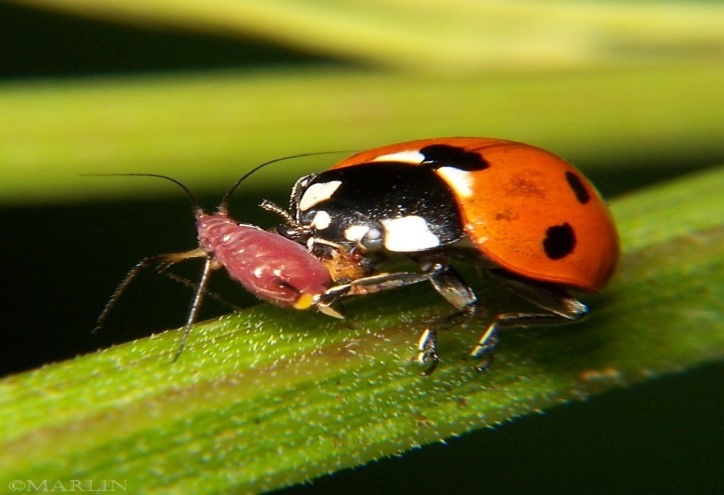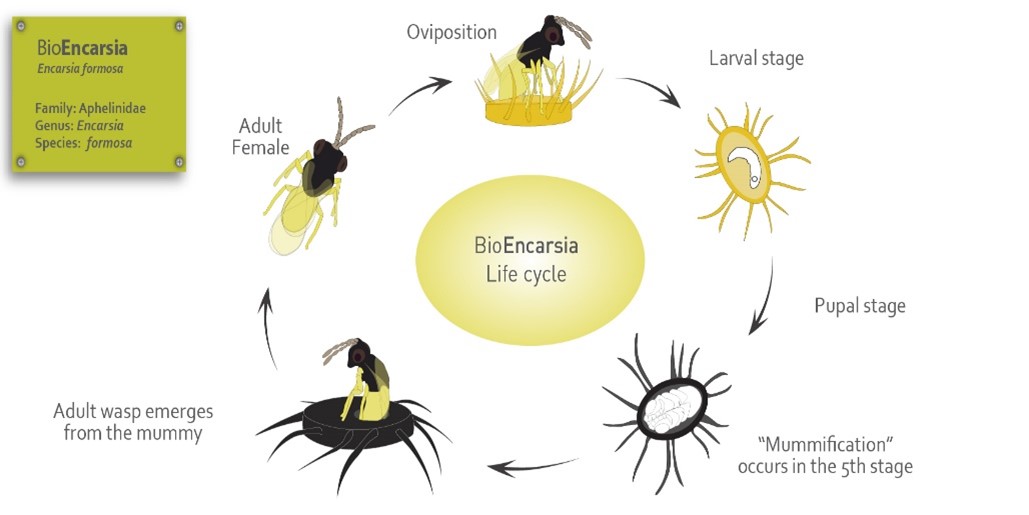Biological control of greenhouse pests using natural enemies
Greenhouses play a vital role in modern agriculture, allowing for year-round cultivation and protection of crops from adverse weather conditions. In Greece, the most important greenhouse crops in terms of acres are tomato, watermelon, cucumber, and pepper plants (Σάββας, 2016). These controlled environments, while providing optimal conditions for plant growth, also create a haven for pests. These pests can seriously harm greenhouse crops, compromising their health and productivity. In the ongoing battle against greenhouse pests, one effective and sustainable solution has emerged: biological control, imitating the power of nature’s own warriors to combat unwanted invaders.
Greenhouse pests consist of a wide range of insects, mites, and other arthropods that feed on plants, suck their liquids, or even transmit diseases. These pests can proliferate rapidly in the warm, sheltered conditions of a greenhouse, leading to severe infestations that can devastate crops if left unchecked. While traditional pest control methods often rely on chemical pesticides, which can be effective but come with several drawbacks, including environmental contamination and the development of pesticide resistance, biological control offers an eco-friendly alternative.
Biological control involves using natural enemies, including predators, parasitoids, and pathogens, to suppress pest populations. These beneficial organisms can be native or introduced species with a particular preference for specific pests, making them highly effective in reducing pest numbers without causing harm to the environment or other non-target organisms (Souza et al., 2019).

Πηγή: (6 Common Greenhouse Pests and How to Manage Them | Ceres Greenhouse, n.d.)
Predatory Insects: The First Line of Defense
Predatory insects are mostly generalists, meaning they prey on many different species of pests. They are much larger than the prey, and more than one biological stage usually behaves predatory. Beetles, lacewings, and predatory mites are commonly used as biological control agents in greenhouses. These voracious predators have evolved to feed on a variety of pests, including aphids, whiteflies, thrips, mealybugs and spider mites. By releasing these beneficial insects into the greenhouse, farmers can establish a natural balance where the predators keep the pest populations under control.
For example, ladybugs are well-known for their appetite for aphids, which are notorious greenhouse pests. A single ladybug can consume dozens of aphids in a day, making them an invaluable asset in pest management. The application is usually done using plastic bottles containing adult insects inside. In high-density infestations, 5000-8000 ladybugs/acre are usually needed. Moreover, it has been found that the use of ladybird species helps reduce aphid population by more than 50% in most cases (Riddick, 2017).
Lacewings, with their delicate appearance, are equally effective hunters, while predatory mites specialize in controlling tiny but destructive spider mite infestations.
Parasitoids: Nature’s Intruders
Another group of beneficial organisms employed in biological control is parasitoids. Most of these insects belong to Hymenoptera and Diptera orders. They are more specialized than predators and much smaller than their hosts. Their big advantage is that they often have much quicker life cycles and can increase in numbers faster than the predators (Souza et al., 2019). These small wasps or flies lay their eggs inside or on the bodies of pests. As the parasitoid larvae develop, they consume the host pest from within, ultimately killing it. This method is highly effective against pests like aphids, caterpillars, and whiteflies.
One example is the tiny parasitoid wasp known as Encarsia formosa, which targets whiteflies. These wasps lay their eggs inside whitefly nymphs. As the wasp larvae develop, they feed on the internal tissues of the whitefly, eventually causing its death. Additionally, the adults can perform host feeding. This process not only kills the whitefly but also disrupts its life cycle, preventing further damage to the greenhouse crops (Gerling, 1966).

Image 2: A species of a ladybug (Coccinellidae spp.) eating an aphid
Microbial Pathogens: Silent Assassins
In addition to predators and parasitoids, microbial pathogens can also be employed as biological control agents. Certain bacteria, fungi, and viruses have effectively controlled greenhouse pests (Souza et al., 2019). For instance, the bacterium Bacillus thuringiensis (Bt) produces a toxin that specifically targets and kills certain caterpillars and beetle larvae, making it a valuable tool in pest management.
When Bt is applied to greenhouse crops, the caterpillars that feed on the treated plants ingest the toxin, leading to their demise. This method is highly selective and safe for other non-target organisms, making it an environmentally friendly choice.
Implementing a Successful Biological Control Program
Implementing a successful biological control program in a greenhouse requires careful planning and continuous monitoring. Farmers must first identify the specific pests they are dealing with and gain an understanding of their life cycles. This information is crucial in determining the appropriate natural enemies to introduce. Timing is also critical; the release of beneficial organisms should coincide with the vulnerable stages of the pest (Μπρούφας & Παππά, 2023).
Regular monitoring of pest populations and natural enemy effectiveness is essential. Farmers must be ready to make any necessary adjustments to the control strategy. In some cases, multiple control methods, including cultural practices and physical barriers, may need to be combined with biological control for optimal results.
The Limitations of Biological Control
While biological control offers numerous benefits, it is important to acknowledge its limitations. It is not always a quick fix and may require time to establish a sustainable balance between pests and natural enemies. In some situations, the use of biological control may not completely eradicate pests but rather keep their populations at manageable levels.

Image 3. Life cycle of Encarsia formosa
Furthermore, the success of biological control can be influenced by external factors such as temperature, humidity, and the availability of alternative food sources for natural enemies (Souza et al., 2019). Consequently, a comprehensive approach to pest management that combines biological control with other strategies may be the most effective way to ensure the health and productivity of greenhouse crops.
Conclusion
In conclusion, the use of predators, parasitoids, and microbial pathogens in biological control exemplifies how nature’s intricate web of interactions can be harnessed for the benefit of agriculture and the environment alike. As we look to a more sustainable future in agriculture, biological solutions stand as a shining example of innovation rooted in nature’s wisdom.
Further reading
Plant – Insect Relation: Plant Defense Mechanisms against Insect Pests
References
6 Common Greenhouse Pests and How to Manage Them | Ceres Greenhouse. (n.d.). Retrieved August 28, 2023, from https://ceresgs.com/6-common-greenhouse-pests-and-how-to-manage-them/
Gerling, D. (1966). Biological Studies on Encarsia formosa (Hymenoptera: Aphelinidae)1. Annals of the Entomological Society of America, 59(1), 142–143. https://doi.org/10.1093/aesa/59.1.142
Riddick, E. W. (2017). Identification of Conditions for Successful Aphid Control by Ladybirds in Greenhouses. Insects, 8(2), Article 2. https://doi.org/10.3390/insects8020038
Souza, B., dos Santos-Cividanes, T. M., Cividanes, F. J., & de Sousa, A. L. V. (2019). Predatory Insects. In B. Souza, L. L. Vázquez, & R. C. Marucci (Eds.), Natural Enemies of Insect Pests in Neotropical Agroecosystems: Biological Control and Functional Biodiversity (pp. 73–87). Springer International Publishing. https://doi.org/10.1007/978-3-030-24733-1_7
Μπρούφας, Γ., & Παππά, Μ. (2023). Εχθροί Λαχανικών και Φυτών Μεγάλης Καλλιέργειας. Κάλλιπος, Ανοικτές Ακαδημαϊκές Εκδόσεις. https://repository.kallipos.gr/bitstream/11419/8592/4/113-BROUFAS-Insect%20pests%20of%20vegetables.pdf
Σάββας, Δ. (2016). Γενική Λαχανοκομία. In Γενική Λαχανοκομία (Vol. 1, pp. 15–19). Εκδοσεις Πεδίο Α.Ε.










































































